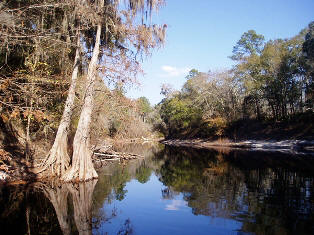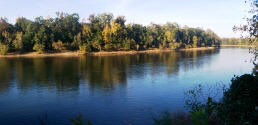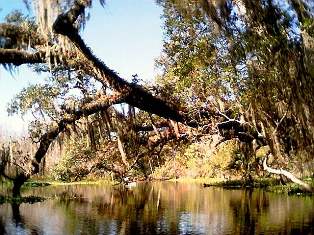Discover Florida Nature
It's time to explore the natural Florida


|
|
|
|
|
|
Florida has over 72 rivers, with over 50,000 miles of rivers and streams
flowing throughout the state. Florida’s famed waterways include the
historic Suwannee River made famous by folk musician Stephen Foster, the
310-mile St. Johns River, one of only a few rivers in North America that
flows north, and Northwest Florida’s Apalachicola River, which helps
supply 90 percent of Florida’s oysters by feeding Apalachicola Bay. Floridians can help protect Florida’s treasured rivers and streams by practicing water conservation habits in their homes and yards, which can be as simple as turning off the faucet while brushing or not running sprinklers on rainy days. By practicing “green” gardening techniques, such as reducing fertilizer use or spreading mulch to prevent erosion, residents can improve the quality of the waters near their homes. since 1990, Florida has acquired more than 2.4 million acres of environmentally-sensitive land to protect water quality in rivers, lakes, estuaries and streams through Florida Forever and its predecessor, P2000. The acreage includes the acquisition of 117,460 acres of natural floodplains and more than 510,000 acres of functional wetlands since July 2001.  Suwannee
River- The Suwannee River is a federally designated wild river.
It is the only major waterway in the southeastern United States that is
still unspoiled. The Suwannee flows from the Okefenokee Swamp in
southern Georgia to the Gulf of Mexico in Florida. It winds for almost
266 miles through swamps, high limestone banks, hammocks of hardwood,
and salt marshes. It also has fifty-five springs along the way. The
Suwannee is the second largest river in Florida in terms of flow, size
of drainage basin and length, and supports more than 60 species of
freshwater fish. The river’s limestone outcroppings and a drop in
elevation create Florida’s only whitewater rapids at Little Shoals and
Big Shoals located several miles
upstream from the city of White Springs. In the 1800s, the sulphur
springs on the Suwannee River at White Springs were promoted as a cure
for almost any ailment. Visitors came seeking to restore their health
“by swimming in the healing water.” A log hotel was built beside the
spring. White Sulphur Springs became noted as a health resort and one of
Florida’s first tourist destinations. Among the resort’s many famous
visitors were Henry Ford and Teddy Roosevelt. Suwannee
River- The Suwannee River is a federally designated wild river.
It is the only major waterway in the southeastern United States that is
still unspoiled. The Suwannee flows from the Okefenokee Swamp in
southern Georgia to the Gulf of Mexico in Florida. It winds for almost
266 miles through swamps, high limestone banks, hammocks of hardwood,
and salt marshes. It also has fifty-five springs along the way. The
Suwannee is the second largest river in Florida in terms of flow, size
of drainage basin and length, and supports more than 60 species of
freshwater fish. The river’s limestone outcroppings and a drop in
elevation create Florida’s only whitewater rapids at Little Shoals and
Big Shoals located several miles
upstream from the city of White Springs. In the 1800s, the sulphur
springs on the Suwannee River at White Springs were promoted as a cure
for almost any ailment. Visitors came seeking to restore their health
“by swimming in the healing water.” A log hotel was built beside the
spring. White Sulphur Springs became noted as a health resort and one of
Florida’s first tourist destinations. Among the resort’s many famous
visitors were Henry Ford and Teddy Roosevelt.  Apalachicola
River- Running through one of the top six biodiversity “hot
spots” in the U.S., the Apalachicola River in Northwest Florida supports
a remarkable collection of habitats and wildlife. The largest river in
Florida in terms of flow, the Apalachicola River stretches 112 miles
from the Georgia border to Apalachicola Bay. Part of a three-river
system, the Apalachicola-Chattahoochee-Flint (ACF) interstate basin
drains 21,794 square miles within Alabama, Georgia, and Florida. The
Chattahoochee River meets sixteen dams, the last at Lake Seminole where
it joins the Flint River and, from there, flows unimpeded through
Florida to the Apalachicola Bay.. The Apalachicola Bay supplies ten
percent of all oysters harvested nationally and is the second largest
National Estuarine Research Reserve in the nation. Apalachicola
River- Running through one of the top six biodiversity “hot
spots” in the U.S., the Apalachicola River in Northwest Florida supports
a remarkable collection of habitats and wildlife. The largest river in
Florida in terms of flow, the Apalachicola River stretches 112 miles
from the Georgia border to Apalachicola Bay. Part of a three-river
system, the Apalachicola-Chattahoochee-Flint (ACF) interstate basin
drains 21,794 square miles within Alabama, Georgia, and Florida. The
Chattahoochee River meets sixteen dams, the last at Lake Seminole where
it joins the Flint River and, from there, flows unimpeded through
Florida to the Apalachicola Bay.. The Apalachicola Bay supplies ten
percent of all oysters harvested nationally and is the second largest
National Estuarine Research Reserve in the nation. St.
Johns River- The St. Johns River is born in marshes, then winds
northward before flowing through Jacksonville. A natural wonder, the St.
Johns River is one of only a few rivers in all of North America that
flows north. Because the river flows north, the Upper Basin is the area
to the south that forms its marshy headwaters in Indian River and
Brevard counties. The Middle Basin is the area in Central Florida where
the river widens, forming lakes Harney, Jessup, Monroe and George. The
lower basin is the area in northeast Florida from Putnam County to the
river's mouth in Duval County, where the river flows into the Atlantic
Ocean. The St. Johns River stretches 310 miles, making it the longest
in Florida. The Wekiva, Econlockhatchee and Ocklawaha rivers are its
major tributaries, helping support populations of
alligators,
large-mouth bass,
blue herons and
bald eagles. The French
Huguenots sailed into the mouth of the St. Johns River in 1562 - about
60 years before Plymouth Rock was founded. Historically the St. Johns
River is America's first river. St.
Johns River- The St. Johns River is born in marshes, then winds
northward before flowing through Jacksonville. A natural wonder, the St.
Johns River is one of only a few rivers in all of North America that
flows north. Because the river flows north, the Upper Basin is the area
to the south that forms its marshy headwaters in Indian River and
Brevard counties. The Middle Basin is the area in Central Florida where
the river widens, forming lakes Harney, Jessup, Monroe and George. The
lower basin is the area in northeast Florida from Putnam County to the
river's mouth in Duval County, where the river flows into the Atlantic
Ocean. The St. Johns River stretches 310 miles, making it the longest
in Florida. The Wekiva, Econlockhatchee and Ocklawaha rivers are its
major tributaries, helping support populations of
alligators,
large-mouth bass,
blue herons and
bald eagles. The French
Huguenots sailed into the mouth of the St. Johns River in 1562 - about
60 years before Plymouth Rock was founded. Historically the St. Johns
River is America's first river. |
|
|
Advertise | Privacy Statement | Dog Encyclopedia | Video |Contact | Alaska Nature |
|